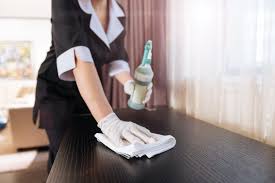Office cleaning isn’t just about dusting desks and emptying bins—it’s about creating a space where people want to work. A tidy workplace reflects professionalism, boosts productivity, and limits health hazards. Yet, even businesses with regular cleaning schedules can fall into bad habits that compromise hygiene and appearance.
Below, we’ll break down common office cleaning mistakes and share actionable fixes, so your workplace stays consistently clean and safe.
Skipping High-Touch Areas in Office Cleaning
One of the most common oversights in office cleaning is forgetting the places people touch most. Light switches, elevator buttons, door handles, shared keyboards, and kitchen appliances all harbour bacteria and viruses.
Why it matters:
High-touch points are hotspots for germs. When neglected, they become breeding grounds that increase the risk of illness in the workplace—especially in flu season.
What to do instead:
Create a checklist of high-touch areas and ensure they’re disinfected daily. Use a disinfectant proven to kill common pathogens, and don’t forget vertical surfaces like fridge handles and cabinet knobs. If you’re outsourcing, confirm your Office Cleaning provider includes these areas in their routine.
Using the Wrong Cleaning Products
Not all surfaces are created equal—and neither are cleaning products. Using general cleaners on tech equipment or strong chemicals on natural surfaces can cause damage.
Why it matters:
Harsh chemicals can corrode delicate surfaces, reduce the life of your office assets, or even trigger allergic reactions among staff.
What to do instead:
Match the product to the material. Microfibre cloths are ideal for monitors and keyboards, while pH-neutral cleaners are better for marble or stone countertops. Always read product labels and store Safety Data Sheets (SDS) where cleaners can access them.
Neglecting Floors, Especially Carpets
Floors—especially carpets—are often vacuumed quickly but not deep-cleaned regularly. Over time, this leads to unpleasant odours, allergens, and a dull appearance.
Why it matters:
Carpets can trap dirt, dust mites, and even mould spores. Without regular deep cleaning, they deteriorate faster and become a health risk.
What to do instead:
Schedule regular steam or dry-clean treatments for carpets—at least twice a year. Hard floors benefit from weekly mopping and occasional polishing. A professional Office Cleaning service will typically advise a schedule based on foot traffic and flooring type.
Overlooking Shared Kitchens and Fridges
The kitchen area can become a breeding ground for bacteria if left unattended. Mouldy containers, sticky benchtops, and dirty microwaves aren’t just unpleasant—they’re health hazards.
Why it matters:
Food contamination can result from poor hygiene. Plus, no one wants to start their day with the smell of last week’s leftovers.
What to do instead:
Implement a weekly fridge clean-out policy (e.g., toss unlabelled items every Friday). Assign cleaning duties or use a service that includes kitchen hygiene in their Office Cleaning scope. Don’t forget less obvious items like the coffee machine or water filter tap.
Forgetting the Air Vents and Filters
Dusty air vents and neglected filters affect indoor air quality and cause odours that no amount of surface cleaning can mask.
Why it matters:
Poor air circulation increases airborne allergens and can contribute to fatigue, headaches, or even Sick Building Syndrome (SBS).
What to do instead:
Schedule quarterly inspections of HVAC systems and replace or clean filters as needed. Cleaning ceiling vents and fans also improves airflow and energy efficiency. This guide from Safe Work Australia outlines indoor ventilation best practices.
Infrequent Deep Cleaning
Surface-level cleaning can hide underlying issues—like mould behind tiles or stains setting into upholstery.
Why it matters:
Without periodic deep cleans, the office gradually declines into a state of disrepair. You might not notice it daily, but new visitors and clients certainly will.
What to do instead:
Book a quarterly or biannual deep clean that covers windows, walls, furniture, air ducts, and fixtures. It helps maintain asset value and workplace hygiene, particularly in open-plan offices or high-density setups.
Cleaning During Business Hours
Cleaning while employees are working is distracting and often leads to corners being cut. Vacuuming, bin changes, or even spraying air fresheners can interrupt phone calls and meetings.
Why it matters:
It disrupts workflow, causes discomfort, and puts cleaning staff at risk of accidental spills or equipment interference.
What to do instead:
Schedule cleaning after hours or early morning. If that’s not an option, divide the office into zones and clean non-occupied areas during peak work times. A good cleaning plan should minimise interruptions while maintaining standards.
No Cleaning Accountability or Feedback Loop
Finally, many businesses don’t track cleaning performance or encourage staff to report issues. A full bin, empty soap dispenser, or overflowing paper shredder might go unnoticed for days.
Why it matters:
Without a clear feedback system, standards slip and minor issues escalate into major complaints or hazards.
What to do instead:
Appoint a facility coordinator or set up an online reporting system for staff. Use simple forms or apps where people can flag issues or give feedback. For outsourced services, ask about performance tracking and regular quality audits.
Final Thoughts
Great office cleaning is more than just routine—it’s about attention to the details that others miss. From dirty carpets to forgotten door handles, the small things make a big difference in hygiene, productivity, and professional appearance.
Whether you’re managing a small workspace or a high-traffic corporate office, avoiding these mistakes helps create a cleaner, safer, and more inviting environment.
Need help building a better routine? Make sure you’re working with professionals who understand what comprehensive Office Cleaning really means.

